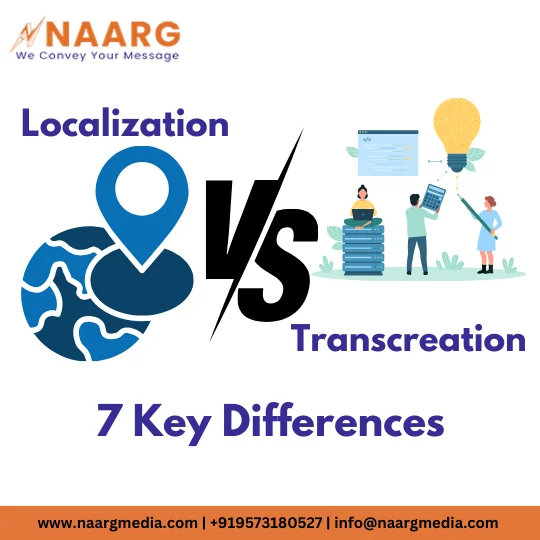Localization vs. Transcreation. But wait, aren’t they all the same? Well, to tell you the truth, no they are not! It may look the same, but from the perspective of a professional translation agency, we can assure you that it is not the same.
The differences are as huge as comparing a tiger to a camel. Only a professional translation agency understands the difference between localization and transcreation and can help you navigate what your project needs.
Do you want to understand the whole debate about localization vs. transcreation? Then read this blog further to help you understand better. In this blog, we will point out 7 key differences between localization and transcreation.
So, let’s get started.

Overview of Localization
Did you know that businesses that invest in translation and localization are 1.5 times more likely to observe an increase in their revenue? So when it comes to localization, the first thing we need to understand is the definition of localization. Localization is the process of adapting your product or service to your specific target market.
When we talk about translation, it is all about the words you use, but localization is more about how well your product or service resonates with your target audience and with their cultures. Localization is a process that starts with the translation process and then moves ahead to address communication issues like measurement units, date formats, etc.
As you know, making any product or service relevant to your potential target audience in a target market has become more challenging than ever before. And regardless of their location, your target audience expects a seamless and personalized experience.
That’s where localization comes into play. Localization is driven by the belief that the human connection transcends all kinds of borders. Hence aiming for a universal connection by building trust and loyalty.
The Process of Localization
When it comes to the process of localization, it is all about modifying, adapting, and restructuring your content for your specific target audience in the target language. And translation is just the beginning part of the localization process. For the localization process, you need to render the meaning, vision, and intent of the product or service to align with the brand as well as local values.
For instance, in the Chinese market, KFC has become one of the largest fast-food chains in China. And why is that? Because KFC has localized its menu according to Chinese tastes and catering according to local preferences.
Some localization professionals often relate the localization process to the idea of transcreation, in which the original content is slightly changed to make it culturally appropriate and relevant to the target audience. With this overview of the localization process, let us also understand what transcreation is.
Overview of Transcreation
When we talk about transcreation, we cannot forget about the process of translation, which is the key part of any transcreation project. The word transcreation is the combination of words translation and creation.
Now if we define transcreation, it is used to redefine the source text from one language to another. It is a creative process that adapts your content while also preserving the original message. The job of transcreators is to not only translate but to recreate the message in the target language.
Transcreators need to consider the main objective of the message, their target audience, and concept description to provide the best results. The transcription process can also involve drastically changing the original text to suit the cultural preferences of the target audience.
The Process of Transcreation
The transcription process is complex, and it takes time to get the final output. You need to provide an ample amount of time to the transcriber to get the desired results. The process of transcreation is highly meticulous and involves several steps to ensure your content resonates culturally and emotionally with your target audience.
For the process of transcreation, a thorough briefing is given to the transcreator to gain an in-depth understanding of the original content. This debriefing is essential to understand the potential of the content and how it can impact the desired target audience. After this debriefing is followed by extensive research into the cultural nuance of the target audience.
Then the transcreator creatively reimagines the content, often rewriting it entirely, to maintain the core message while making it relevant to the new target audience. This transcreator often collaborates with cultural experts and local copywriters to fine-tune the content. That is how the transcreation process takes place and the content is transcreated.
7 Key Differences Between Localization and Transcreation
Both these processes—transcreation and localization—are two critical processes in adapting your content for different target markets and audiences. So, to help you understand better, we have listed seven key differences between localization and transcreation.
1. Objective
As far as it is concerned with localization, the main goal is to adapt content so that it is linguistically and culturally appropriate for a specific target market. So, localization includes translating the original text and adjusting elements like date formats, units of measurement, and currency to fit the local conventions. Whereas the primary objective of transcreation is to convey the same original content by creatively adapting the content rather than a direct translation.
2. Scope of Work
The localization process involves translating text and modifying elements just to fit the local regulations, cultural norms, and preferences. This includes changing UI elements, graphics, and multimedia. Whereas transcreation involves rewriting and recreating content to resonate with your target audience. Now this involves significant alterations of creative elements.
3. Level of Creativity
The localization process requires a thorough understanding of the target language and culture, primarily following the structure and meaning of the source content. Whereas the name justifies, the transcription process requires a high degree of creativity and copywriting skills. Because of transcreation, the content may be entirely reimagined to achieve the desired impact.
4. Fidelity to Source Material
The localization process aims for accuracy, ensuring that the localized content remains as close to the original in meaning and structure as possible. While just making necessary adjustments for local relevance. While transcreation prioritizes effectiveness and emotional resonance of the content over literal accuracy. In this process, the final content may differ significantly from the source content.
5. Usage Scenarios
The localization process is commonly used for software interfaces, manuals, websites, and technical documents where accurate and precise translation is crucial. The transcreation process is often used in marketing and advertising materials, brand names, slogans, and any content where persuasive and emotional power is essential.
6. Target Audience
Localization process focuses mainly on making content functional and understandable for the target audience by aligning the content with local preferences and local norms. Transcreation focuses on creating a strong emotional connection with the target audience. Which requires a deep understanding of local cultural nuances and consumer behavior.
7. Process Involvement
For localization, it typically involves translators, localization engineers, and cultural consultants who ensure linguistic and technical accuracy. Whereas transcription involves copywriters, cultural experts, and marketers who collaborate to recreate content that achieves the intended psychological effect in the desired target market.
So, understanding all these differences is crucial for any business aiming to effectively reach and engage its target audience. Thus ensuring that your content not only speaks the desired language but also resonates deeply with your target audience.
Contact us today to learn more about our professional services.

